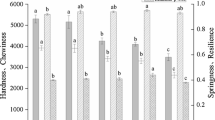Abstract
A total of 100 broiler breast meat was cooked at 176°C to internal temperatures of either 71, 73, 75, 77, or 79°C. Tenderness significantly decreased as internal temperatures increased. The decrease was most pronounced at 79°C with a 26.4% increase in Meullenet-Owens-Razor-Shear (MORS) energy compared to that at 71°C. The toughness-temperature coefficient (TTC, change in tenderness/1°C increase) was calculated to be 4.48% across the temperature ranges. Cooking loss increased constantly with the increase of internal temperatures and ranged from 15 to 27% across the range of endpoint temperatures. Poultry breast meat cooked to a higher internal temperature was in average less tender and also more variable in tenderness.
Similar content being viewed by others
References
Davis SB. Prediction of poultry texture attributes from alternative instrumental and data analyses. MS thesis, University of Arkansas, Fayetteville, AR, USA (2000)
Smith DP, Lyon CE, Fletcher DL. Comparison of the Allo-Kramer shear and texture profile methods of broiler breast meat texture analysis. Poultry Sci. 67: 1549–1556 (1988)
Hostetler RL, Dutson TR, Carpenter ZL. Effect of varying final internal temperature on shear values and sensory scores of muscles from carcasses suspended by two methods. J. Food Sci. 41: 421–423 (1976)
Sams AR. Portion control & tenderness: Big & tender? WATT Poultry USA (April): 23–27 (2002)
Ang CYW, Huang YW. Internal temperature and packaging system affect stability of cooked chicken leg patties during refrigerated storage. J. Food Sci. 58: 265–269 (1993)
Lee YS, Owens CM, Meullenet JF. On the quality of commercial boneless skinless broiler breast meat. J. Food Sci. 73: S253–S261 (2008)
Bourne MC. Effect of temperature on firmness of raw fruits and vegetables. J. Food Sci. 47: 440–444 (1982)
Cavitt LC, Meullenet JF, Xiong R, Owens CM. The relationship of razor blade shear, Allo-Kramer shear, Warner-Bratzler shear, and sensory tests to changes in tenderness of broiler breast fillets. J. Muscle Foods 16: 223–242 (2005)
Lyon BG, Lyon CE. Assessment of three devices used in shear tests of cooked breast meat. Poultry Sci. 77: 1585–1590 (1998)
Meullenet JF, Xiong R, Saha A, Owens CM. Novel shape profiling method for classifying tender and tough broiler breast meat (abstract no. 97-2). In: Abstracts: IFT Annual Meeting. July 15–20, Convention Center, New Orleans, LA, USA. Institute of Food Technologists, Chicago, IL, USA (2005)
Sanderson M, Vail GE. Fluid content and tenderness of three muscles of beef cooked to three internal temperatures. J. Food Sci. 28: 590–595 (1963)
Author information
Authors and Affiliations
Corresponding author
Rights and permissions
About this article
Cite this article
Hong, IK., Lee, YS. Textural properties and water-holding capacity of broiler breast meat cooked to various internal endpoint temperatures. Food Sci Biotechnol 21, 1497–1499 (2012). https://doi.org/10.1007/s10068-012-0198-7
Received:
Revised:
Accepted:
Published:
Issue Date:
DOI: https://doi.org/10.1007/s10068-012-0198-7




